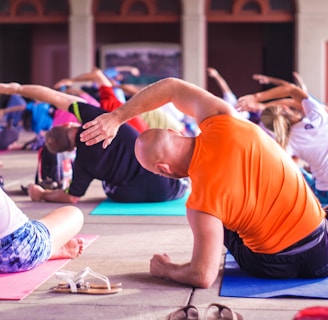Want a Daily Fitness Plan to Slow-down Aging?
Blog post with Additional useful Fitness exercises as part of your Plan.
FITNESSNEWS
M. Edwards
10/16/20252 min read


Deep Dive: Want a Daily Fitness Plan to Slow Aging? (Especially After 50)
Here’s more info on 5 proven workouts, mechanisms, science, and a printable plan to get started.
We all age, but how gracefully we age can be determined by how healthy we live those years. A daily fitness plan is one of the most accessible, evidence-based ways to slow the rate of aging, not by freezing time, but by preserving strength, cognition, resilience, and molecular health. In this article, you’ll discover the science behind it, 5 specific workouts you can adopt, and tips to make it sustainable for those 50+ years and beyond.
Why fitness matters in aging: Reduced disease burden & mortality. People who stay active and maintain good cardiorespiratory fitness have substantially lower risk of dying prematurely. Large cohort studies show graded benefit: more fitness = lower mortality.
Muscle & bone preservation. As we age, muscle mass tends to decline (sarcopenia), increasing frailty. Resistance work preserves strength, function, and bone density.
Improved metabolic health. Exercise improves insulin sensitivity, reduces visceral fat, lowers blood pressure, and reduces chronic inflammation — all drivers of age-related disease.
Molecular & cellular effects. Recent research links higher activity to longer telomeres, improved mitochondrial function, and younger epigenetic age.
Brain & cognitive benefits. Regular movement supports neuroplasticity, mood, and memory through increased blood flow, neurotrophic factors (BDNF), and reduced oxidative stress.
The takeaway? Movement is among the few levers we can pull that influence aging from whole-body down to the cell.
Here are 5 workouts designed to cover cardio, strength, balance, and mobility. Rotate or combine them.
1. Interval walking / power walk (One of my favorites)
Warm up with 5 min easy pace.
Alternate 1 min brisk (or fast) pace + 1–2 min regular pace, repeat 8–12 cycle
Cool down 5 min
Modification: If walking is hard, use a recumbent bike or swimming for intervals.
2. Sit-to-stand (chair squat) + tempo variation
Using a sturdy chair (without wheels), stand up fully, then sit down slowly over 4–5 seconds, then stand quickl
Do 10–15 reps × 2 sets
Modification: Use a higher chair, or assist with hands lightly on thighs or counter.
3. Resistance band / dumbbell row + reverse fly
Anchor a resistance band (or use dumbbells
Row: pull elbows directly back, squeezing shoulder blades (12–15 reps)
Reverse fly: arms out to side, in a slight bend, open chest (12–15 reps)
Modification: Do seated version, or use lighter resistance.
4. Wall push-ups + knee push-ups
Start with wall push-ups (hands on wall) 10–15 reps
As strength grows, move to incline (table) or knee push-ups (on floor, knees)
Modification: Change angle to reduce load, or do fewer reps.
5. Calf raises + single-leg balance + hip flexor march
Calf raises: 2 sets × 15 reps (both feet → rise on toes slowly)
Single-leg balance: hold one leg up for 15–30 seconds, switch sides
Hip flexor march: standing, lift knee up toward chest one at a time (10 each side)
Modification: Use support, reduce hold times, do seated marches.
Build a daily fitness plan using these workouts. Create a weekly structure, and stick to it!
Medical check: If you have chronic disease, heart issues, or joint problems, consult your clinician before launching heavy exercise.
Conclusion & Call to Action
Fitness is one of the most potent tools in your antiaging toolkit. With just 5 simple workouts, you can build a daily fitness plan that reinforces strength, balance, cardiovascular health, and cellular resilience. The key is consistency, gradual progression, and adaptation to your body’s needs.
You don’t have to be perfect — just move daily, stay curious, and let your body age more gracefully.


Rejuvenation
AntiAgingCafe@yahoo.com
© 2024-25, Antiagingcafe.net. All rights reserved.
copyright 2024, theAntiagingcafe.com / ANTIAGINGCAFE.NET Copyright 2024, Michael Edwards. All rights reserved. WWW.ANTIAGINGCAFE@YAHOO.COM
As an affiliate, I may earn commissions from qualifying purchases made through links on this site, including Amazon and other partners. This does not affect your purchase price.
AntiAgingCafe.net / TheAntiAgingCafe.com, including our related sites, and other associated channels, including YouTube, Instagram, and Pinterest, provides a "menu" of various topics which may includes or present informational-based content, which is solely for information and educational purposes only, and in no manner does it offer or suggest any medical advice , cures, or recommendations for the reader. No medical advice is given by AntiAgingCafe, whether suggested by third-party articles, their research results, or suggested by third-parties from their studies are provided, or suggested, to our readers. Any news articles, research or studies, claims or product descriptions, provided by various third party assumptions; All information listed on our site, or presented by our sites or channel, are presented for broad informational use only, and in no manner medical or treatment advice. It is the responsibility of the reader to review and evaluate all articles and suggestions posted on these pages. We encourage readers to seek professional medical advice for their specific health concerns. Your health is important, and adequate consultation with qualified professionals is always recommended.